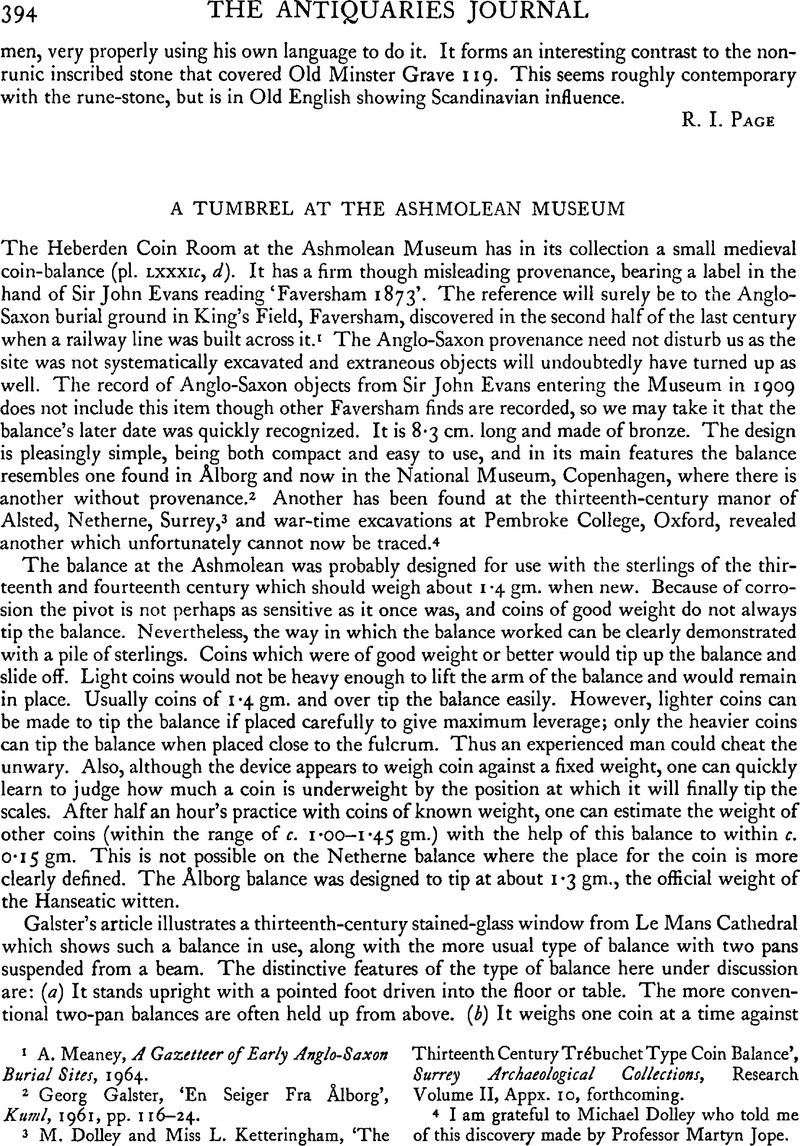Article contents
A Tumbrel at the Ashmolean Museum
Published online by Cambridge University Press: 29 November 2011
Abstract

- Type
- Notes
- Information
- Copyright
- Copyright © The Society of Antiquaries of London 1975
References
page 394 note 1 A. Meaney, A Gazetteer of Early Anglo-Saxon Burial Sites, 1964.
page 394 note 2 Georg Galster, ‘En Seiger Fra Ålborg’, Kuml, 1961, pp. 116–24.
page 394 note 3 M. Dolley and Miss L. Ketteringham, ‘The Thirteenth Century Trébuchet Type Coin Balance’, Surrey Archaeological Collections, Research Volume II, Appx. 10, forthcoming.
page 394 note 4 I am grateful to Michael Dolley who told me of this discovery made by Professor Martyn Jope.
page 395 note 1 Galster, op. cit. The etymology is discussed by Edward Schröder in Zeitschrift für Numismatik, xxiv (1904), p. 343Google Scholar, s.v. ‘Saiga’. Seiger is in fact the word for the balance mechanism of a clock, as distinct from ‘Zeiger’ the word for a watch-hand.
page 395 note 2 E. Hucher, Caiques des vitraux feints de la cathédrale du Mans, 1864.
page 395 note 3 J. E. Mansion, Harrap's New Standard French and English Dictionary, 1972.
page 395 note 4 R. Ruding, Annals of the Coinage of Great Britain and its Dependencies i, 198–9.
page 395 note 5 Statute 20. E.I. Stat. 4 (1556 Tottels edition).
page 395 note 6 The Ashmolean Tumbrel shows no sign of the king's stamp; nor, Miss Ketteringham tells me, does the Netherne balance.
page 395 note 7 Suchodolski, S., Mennictwo polskie w XI–XII wieku, Warsaw 1973, p. 150 (English)Google Scholar.
page 395 note 8 M. Dolley and L. Ketteringham, loc. cit.
page 395 note 9 W. Thorne, Chronica, edn. Tueysden, 1652, col. 2068, and W. Geiger, ‘Geldwechsel im Jahre 1500’, Schweizer Münzälatter, May 1964, pp. 113–14.
page 395 note 10 Municipal Laws for Freiborg, Erfurt (1329), and Augsburg (1498), German Coinage Acts 1385, 1551, 1559.
page 396 note 1 Rogers, J. E. Thorold, A History of Agriculture and Prices in England, Oxford, 1866, i, pp. 75–6Google Scholar, believed, I think wrongly, that payments were generally made by weight.
- 2
- Cited by


